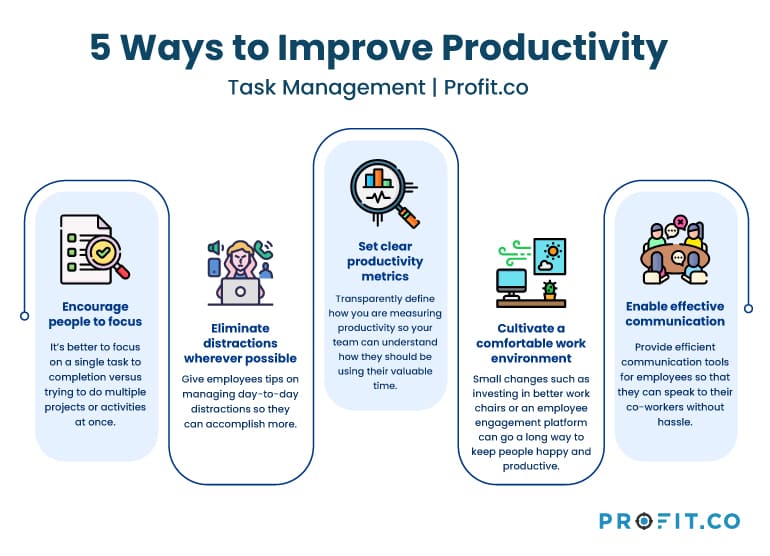“Productivity” is a term that gets tossed around a lot. There are tons of apps, programs, classes, and even diets that all purport to help you increase your productivity both at work and in your personal life.
Bosses and managers always want more productivity and are constantly looking for ways to measure it. And most of us have an innate feeling that tells us when we are or aren’t being “productive.” But if you’ve ever asked yourself what exactly does that word mean, then you aren’t alone.
It’s not always that we need to do more but rather that we need to focus on less.
This article breaks down what productivity really means, what its benefits are, and what you can do to boost your productivity and accomplish more. Let’s dive right in!
How is Productivity Defined?
Before you can measure or increase something, you have to understand what it is. In short, a good definition for productivity is the measure of output for every input. In your job, this might mean the number of tasks you complete in a given timeframe. Increasing your productivity means getting more quality work done in less time. It’s getting the maximum results from your efforts.
Outputs are simply the end products, goods, and services that are created or rendered. Inputs are things like the raw materials, equipment and machinery, costs, and the labor from employees that go into making it all happen.
The formula itself looks like this:
Productivity = Units of Output / Units of Input
Let’s take a practical example to give you a better idea. Say Company A was able to manufacture $200,000 worth of products over the course of about 650 hours. Plugging the numbers into our formula, productivity would be calculated as $200,000/650. That means you’re making approximately $308 worth of goods per hour.
In order to improve productivity, you first have to measure it. It’s a great idea to have a task or goal management platform to transparently track your team’s progress on important objectives or projects. You can try Profit.co’s OKR and task management system free for thirty days!
What Are The Benefits of Productivity
Encouraging and promoting productivity within your team has many benefits. There are the obvious ones like increased performance and the financial gains from producing more. However, there are some other tangible advantages as well.
For one, you’re able to reach goals and milestones set which boosts the morale and job satisfaction of employees and management. As processes and procedures become more streamlined, it makes things better for the end customer too. For example, if you work at a grocery store and the staff is productive, items and stock will quickly be replenished and be there when the customer wants it.
Now that you understand the benefits of being productive, let’s take a look at some ways you can increase productivity. Most will apply to the workplace, but there are some tips you can implement in your personal life as well.
How Do You Improve Productivity?

Specific methods and approaches to increase productivity largely depend on what the company’s end goals are, what the workplace culture is like, and the general procedures that are already in place.
Productivity is a complex subject, so it’s a good rule of thumb to check in and get feedback from staff and management on how they perceive their team’s productivity. Here are a few things you can do to improve productivity in the office:
Encourage people to focus. A lot of people believe they can be effective multi-taskers. But the truth is, the idea that multitasking makes you more productive is a myth. It’s better to focus on a single task to completion versus trying to do multiple projects or activities at once. Each time you switch what you’re working on, it takes time to get back into the motions and mindset, so it’s better to see something through to the end before starting on another task.
There should be clear metrics for productivity. KPIs around profits and losses are prevalent metrics most companies are very familiar with. However, developing high-level leading metrics that give insights into productivity can be challenging. The two KPIs at the forefront now are derived from the aforementioned formula. They are “output per worker” and “output per hours worked.” Transparently define how you are measuring productivity so your team can understand how they should be using their valuable time.
Eliminate distractions where you can. Sometimes, distractions can’t be avoided. However, there are things you can do to help manage them. For instance, take a look at current workplace culture and norms. Are there behaviors and attitudes that contribute to people breaking their concentration and losing focus? Give employees tips on managing day-to-day distractions so they can accomplish more whether they’re working on-site, remotely, or in a hybrid work model.
Allow and promote easy, effective communications. To work as a cohesive unit, the team needs to be able to effectively communicate with each other. That means effectively making use of tools like email, texts, and phone calls. Employees should be able to speak with their co-workers without hassle, so give them the option to easily contact each other using a variety of tools.
Develop and design a comfortable work environment. This ties back with eliminating distractions because one of the biggest ones is working in an uncomfortable and disorganized workplace. You don’t need to tear down the building and do a complete rehaul. Small changes can have big impacts– something like investing in better and more comfy work chairs or an employee engagement platform can go a long way to keep people happy and productive.
The real driver of workplace productivity comes from strong, thoughtful leadership. They need deep insights into what factors do and don’t affect performance. Sometimes, the problem is that employees don’t have the tools they need. And other times, it’s the environment itself that’s taking away from productivity.
Final Thoughts
As the world slowly returns back to normal after the pandemic, productivity is going to be a major priority for the companies that still have work-from-home employees and hybrid environments. Though this was a brief overview, productivity is a complex concept but the benefits are obvious. So mastering the skill of effectively boosting productivity in your team will be crucial to the future success of companies and individuals alike.
To learn more about how Profit.co’s OKR and task management software can help your team stay productive, book a free demo with our experts!

